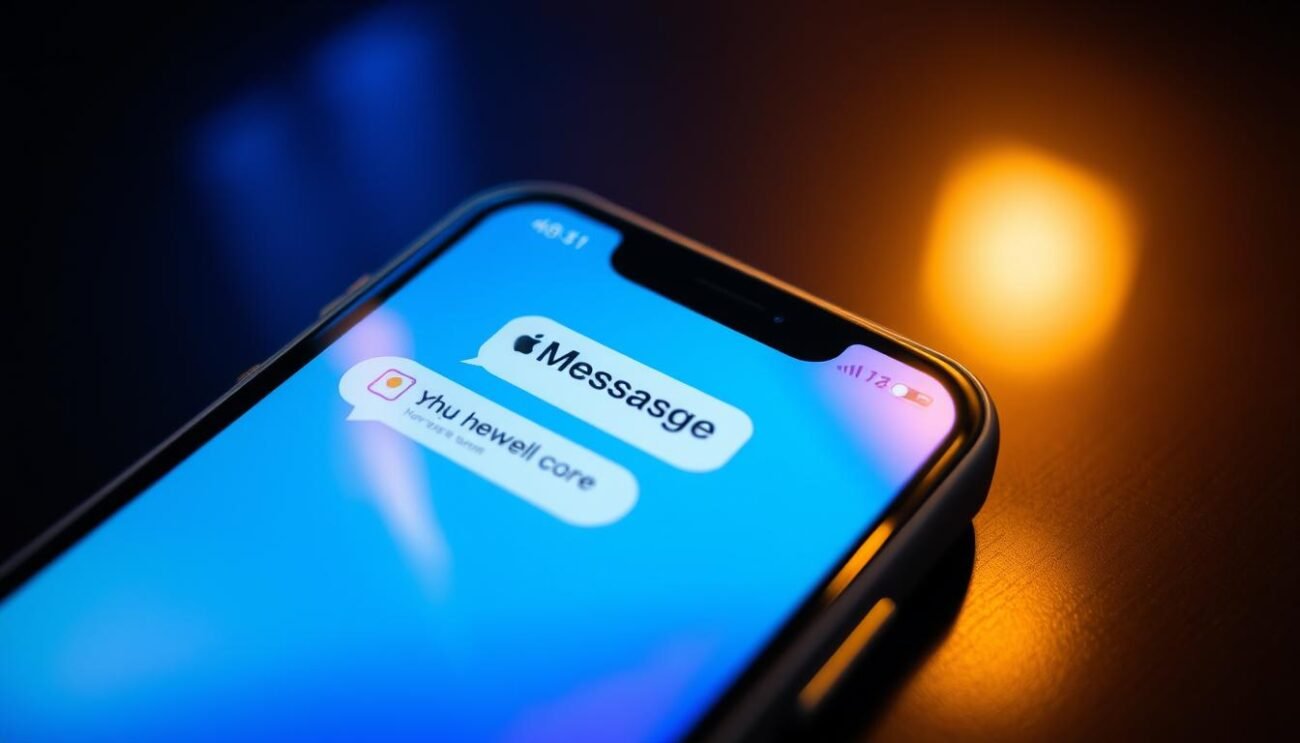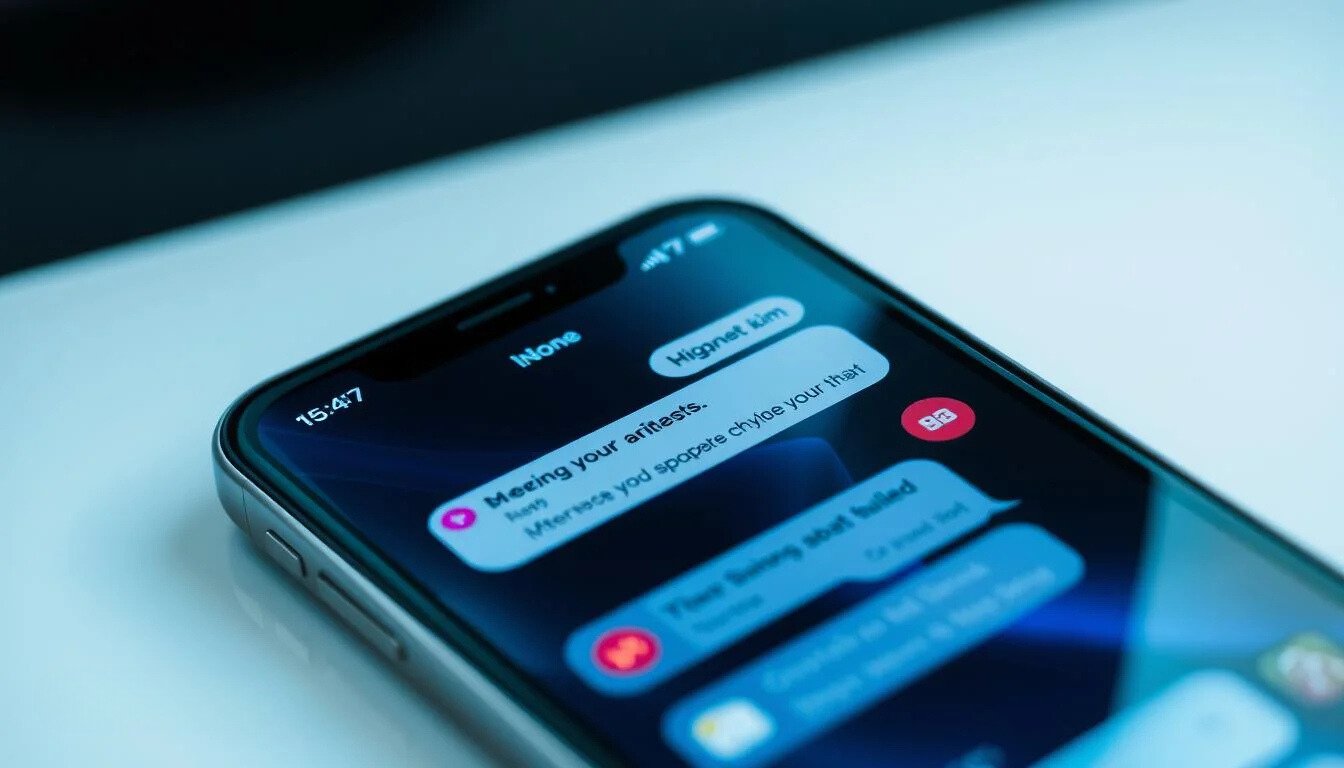Have you ever experienced frustrating iPhone display message issues that disrupt your device’s functionality? Whether it’s a persistent notification glitch or a puzzling system alert, these message problems can be a real headache. But fear not, as this comprehensive guide is here to help you resolve these challenges and restore your iPhone’s messaging system to its optimal performance.
What if there was a simple, step-by-step solution to fix your iPhone’s display message woes once and for all? Discover the key to unlocking a seamless messaging experience on your iOS device by delving into this informative article.
Key Takeaways
- Understand the common types of iPhone display messages and their causes
- Explore effective troubleshooting methods to resolve message-related issues
- Learn how to customize your iPhone’s alert settings for better message management
- Discover solutions for addressing persistent iMessage and security-related display problems
- Optimize your iPhone’s message display settings for enhanced performance
Understanding Common iPhone Display Message Issues
When it comes to iPhones, display messages are a common occurrence that can range from push notifications to system alerts. These messages play a vital role in keeping users informed and engaged with their Apple device messages. However, understanding the types of display messages, why they occur, and how they impact the user experience is crucial for effectively troubleshooting and resolving any issues related to iPhone notifications or system prompts.
Types of Display Messages on iOS Devices
iPhone users may encounter various types of display messages, including:
- Push notifications: These are the alerts that pop up on your iPhone’s screen, informing you of new messages, app updates, or other important information.
- System alerts: These are system-level messages that appear to notify you of important system-related events, such as low battery or storage issues.
- In-app messages: Some apps may display their own custom messages within the app interface, providing contextual information or requesting user input.
Why Display Messages Occur
Display messages on iPhones can occur for a variety of reasons, such as:
- Incoming notifications from apps or the system
- Changes in system settings or configurations
- Security-related events or authentication requirements
- Troubleshooting or diagnostic information
Impact on User Experience
The frequency, timing, and relevance of display messages can have a significant impact on the overall user experience. Excessive or irrelevant messages can be disruptive, while timely and informative messages can enhance the user’s productivity and engagement with their iPhone notifications and Apple device messages. Understanding the iPhone system notifications and their impact is crucial for optimizing the user experience on iOS devices. If your notifications are acting up, a simple restart might resolve the issue. Here’s a quick guide with tips on restarting your phone.
“Effective display message management is key to a seamless and enjoyable iPhone user experience.”
Quick Solutions for iPhone Message Pop-up Problems
Dealing with persistent iPhone screen pop-ups or unwanted display prompts can be a frustrating experience. Fortunately, there are some quick and easy solutions to address these common issues. By following these simple steps, you can quickly resolve minor iPhone message pop-up problems without diving into complex troubleshooting methods.
- Force Restart Your iPhone: A basic troubleshooting step, force restarting your device can often resolve stuck message bubbles or persistent notifications. Simply hold down the Power and Home buttons (or Volume Down and Power buttons on newer models) until the Apple logo appears.
- Clear Recent App Cache: Certain apps may be triggering unwanted iPhone screen pop-ups or iPhone display prompts. Close out of all apps and then clear their cached data to see if that resolves the problem.
- Disable Notification Previews: If you’re encountering issues with message notifications, try turning off the “Show Previews” option in your iPhone’s Settings > Notifications menu. This can help minimize distracting pop-ups.
By implementing these quick fixes, you can often address and resolve common iPhone screen pop-ups and iPhone display prompt problems without the need for more extensive troubleshooting. Remember, these solutions are designed to address minor display-related issues, and more complex problems may require additional steps or professional assistance.
“Dealing with persistent iPhone screen pop-ups can be a frustrating experience, but these quick solutions can help resolve the problem.”
Essential Steps to Troubleshoot iPhone Display Message
When dealing with iPhone display message issues, it’s crucial to follow a comprehensive troubleshooting process to identify and resolve the problem. From basic methods to advanced techniques, let’s explore the essential steps to get your iPhone messaging experience back on track.
Basic Troubleshooting Methods
Sometimes, the solution to an iPhone display message problem can be as simple as a quick restart. Begin by powering off your device, waiting a few moments, and then turning it back on. This can often clear temporary glitches and reload system settings, resolving the issue. Additionally, check your iPhone’s notification and alert settings to ensure they are configured correctly.
Advanced Problem-Solving Techniques
If the basic methods don’t yield the desired results, it’s time to delve deeper. Try resetting your iPhone’s network settings, which can address connectivity-related display message problems. Another option is to update your iOS to the latest version, as software updates often include bug fixes and performance enhancements that can resolve various iPhone display message and iOS messaging issues.
When to Seek Professional Help
For persistent or complex iPhone alert problems that don’t respond to your troubleshooting efforts, it may be necessary to seek professional assistance. Contact Apple Support or visit an authorized Apple service center to have your device evaluated by experts. They can diagnose the underlying cause and provide tailored solutions to get your iPhone functioning properly again.
By following these essential steps, you can effectively troubleshoot and resolve a wide range of iPhone display message problems, ensuring a seamless and uninterrupted messaging experience on your device.
Fixing Notification Banner Display Issues
iPhone users often encounter problems with their notification banners, from missing banners to overlapping notifications or incorrectly displayed content. Fortunately, there are several effective solutions to address these issues and ensure a seamless notification experience. One simple yet effective fix is rebooting your device—check out this quick info for every device to learn how.
Adjusting Notification Settings
One of the first steps in resolving notification banner problems is to review and adjust your iPhone’s notification settings. Navigate to the “Settings” app, then to the “Notifications” section. Here, you can customize the behavior of each app’s notifications, including whether they appear as banners or alerts, and the duration of their display.
Managing App Permissions
Certain apps may require specific permissions to properly display their notification banners. Check the “Notifications” settings for each app and ensure that the necessary permissions, such as “Allow Notifications,” are granted. This will help prevent any conflicts or restrictions that could impact the display of your iPhone’s notification banners.
Troubleshooting App-Specific Issues
If you’re experiencing issues with notification banners from a specific app, try the following steps:
- Force-quit the app and relaunch it.
- Update the app to the latest version, as newer updates may address known display problems.
- Disable and then re-enable the app’s notification settings within the “Notifications” menu.
By following these targeted solutions, you can effectively address a wide range of iPhone notifications and iPhone banners display problems, ensuring a seamless and organized notification experience on your device.
| Issue | Solution |
|---|---|
| Missing notification banners | Check notification settings, ensure app permissions are granted |
| Overlapping notification banners | Adjust notification settings, disable unnecessary notifications |
| Incorrectly displayed notification content | Force-quit the app, update to the latest version, reset notification settings |

“Keeping your iPhone’s notification settings optimized is key to maintaining a clutter-free and efficient user experience.”
Resolving System Alert Messages and Prompts
As iPhone users, we often encounter system-level alert messages and prompts that can disrupt our daily workflows. These notifications, while important, can sometimes become a nuisance if not properly managed. In this section, we’ll dive into the common system alerts, explore strategies for managing alert settings, and discover ways to customize alert behaviors for a more seamless iPhone experience.
Common System Alerts
iPhone system notifications can cover a wide range of topics, from security updates and storage warnings to location-based reminders and app permissions. Some of the most frequent system alerts users may encounter include:
- Software update notifications
- Low storage space alerts
- Location services permission prompts
- Two-factor authentication requests
- Backup and iCloud sync notifications
Managing Alert Settings
To regain control over these system alerts, iPhone users can navigate to the Settings app and explore the Notifications menu. Here, they can customize the behavior of various app and system notifications, including:
- Turning alerts on or off for specific apps
- Adjusting the alert style (banners, alerts, or none)
- Selecting the sound or vibration pattern for notifications
- Enabling or disabling badges for unread alerts
- Scheduling Do Not Disturb modes to minimize interruptions
Customizing Alert Behaviors
Beyond managing notification settings, iPhone users can also explore ways to customize the alert behaviors to better suit their preferences. This may include:
- Muting specific alert types: Users can silence certain system alerts, such as software update reminders or storage warnings, to reduce interruptions.
- Prioritizing important notifications: By adjusting the alert styles and sounds for critical alerts, users can ensure they don’t miss important system messages.
- Scheduling Do Not Disturb periods: Scheduling specific times or locations for Do Not Disturb mode can help minimize distractions during important tasks or while sleeping.
By understanding and managing these system-level alerts, iPhone users can optimize their device’s performance, minimize unwanted interruptions, and personalize their overall user experience.
How to Handle Persistent iMessage Display Problems
Dealing with consistent issues related to the display of iOS messaging can be a frustrating experience for iPhone users. From message delivery hiccups to syncing problems across devices, the iMessage platform is not immune to its fair share of glitches. Fortunately, there are strategies you can employ to address these persistent display problems and regain control of your messaging experience.
Troubleshooting iMessage Delivery Failures
One common iMessage display issue is the failure to successfully deliver messages to intended recipients. This can be caused by a variety of factors, including network connectivity, account settings, or even device compatibility. To resolve delivery problems, try the following steps:
- Ensure your iOS messaging and device settings are configured correctly, including your Apple ID and iMessage activation status.
- Check your internet connection and try toggling Airplane Mode on and off to reset the network connection.
- Force quit the iPhone display message app and relaunch it to see if that clears the issue.
Syncing iMessage Across Multiple Devices
Another common challenge is maintaining consistent message display and synchronization across all your Apple devices. This can be particularly problematic when using iMessage on your iPhone, iPad, and Mac simultaneously. To streamline the syncing process:
- Verify that you’re signed in to the same Apple ID on all your devices.
- Ensure iMessage is enabled and properly configured on each device.
- If you’re still experiencing issues, try disabling and re-enabling iMessage on your devices to force a refresh.
By addressing these persistent iOS messaging and iPhone display message problems, you can regain control of your communication channels and enjoy a seamless messaging experience across all your Apple devices.

Solutions for iPhone Display Message Authentication Errors
As Apple device users, we often encounter various display message issues on our iPhones, including security-related messages, verification problems, and account settings challenges. These authentication errors can be frustrating, but there are effective solutions to resolve them and ensure your messaging services function properly and securely.
Security-Related Messages
Security-related display messages on your iPhone may indicate potential threats or unauthorized access attempts. These messages often require your immediate attention to protect the integrity of your device and personal information. To address such security-related messages, follow these steps:
- Carefully review the message and understand the security concern it is highlighting.
- Take appropriate actions, such as updating your device’s operating system, changing account passwords, or verifying your device’s settings.
- If the message persists or you’re unsure of the appropriate action, consider seeking assistance from Apple’s support team or a trusted technology professional.
Verification Problems
Verification issues can arise when your iPhone is unable to authenticate your identity or account credentials. This can prevent you from sending or receiving messages or accessing certain features. To troubleshoot verification problems:
- Ensure your account information, including username and password, is up-to-date and valid.
- Check for any pending software updates and install them to resolve potential compatibility issues.
- If the problem persists, you may need to contact your service provider or the app developer for further assistance.
Account Settings Issues
Incorrect or outdated account settings can also cause display message problems on your iPhone. To address account settings issues:
- Review your device’s Settings app and ensure your Apple ID, iCloud, and other relevant account settings are properly configured.
- Verify that your notifications and alert preferences are set to your desired preferences.
- If you’re unsure about specific settings, consult Apple’s support resources or consider seeking professional help to ensure your iPhone is properly set up for optimal messaging performance.
By addressing security-related messages, verification problems, and account settings issues, you can effectively resolve various Apple device messages and iPhone alerts that may be impacting your messaging experience. For insights into the latest Apple advancements, such as the iPhone 15 Pro Max’s back design and features, check out this detailed guide. Remember, seeking assistance from Apple’s support team or a qualified technician can be invaluable when dealing with persistent display message authentication errors.
Optimizing Message Display Settings for Better Performance
To enhance your iPhone messaging experience, it’s essential to fine-tune the display settings for your messages. By managing notification grouping, customizing preview content, and adjusting display duration, you can ensure that important messages are effectively presented on your device.
Firstly, consider customizing your notification settings to group similar messages, reducing clutter and making it easier to stay organized. This feature allows you to combine notifications from the same app or conversation, providing a more streamlined view of your incoming messages.
Additionally, you can manage the preview content displayed for your messages. Adjust these settings to control how much information is shown in the notification, striking a balance between conciseness and providing enough context to avoid unnecessary unlocking of your device.














































